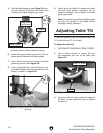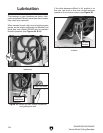
-39-
G8144Z/G8145Z/G8146Z
Vertical Metal Cutting Bandsaw
Review the troubleshooting and procedures in this section to fix or adjust your machine if a problem devel-
ops. If you need replacement parts or you are unsure of your repair skills, then feel free to call our Technical
Support at (570) 546-9663.
SECTION 7: SERVICE
Troubleshooting
Motor & Electrical
Symptom Possible Cause Possible Solution
Machine does not
start or a breaker
trips.
1. Power switch key is removed or not in ON
position (Model G8146Z only).
2. Emergency stop push-button is engaged/
faulty (Model G8146Z only).
3. Plug/receptacle is at fault or wired incor
-
rectly.
4. Motor connection wired incorrectly.
5. Wall fuse/circuit breaker is blown/tripped.
6. Power supply switched OFF or is at fault.
7. Wiring is open/has high resistance.
8. Start/Stop switch is at fault (Model G8144Z/
G8145Z).
9. Inverter is at fault.
10. Motor is at fault.
1. Install power switch key and turn it to the ON posi
-
tion.
2. Rotate clockwise until it pops out; replace it if faulty.
3. Test for good contacts; correct the wiring.
4. Correct motor wiring connections (
Page 51).
5. Ensure circuit size is suitable for this machine;
replace weak breaker.
6. Ensure power supply is switched on; ensure power
supply has the correct voltage.
7. Check for broken wires or disconnected/corroded
connections, and repair/replace as necessary.
8. Replace Start/Stop switch.
9. Replace inverter.
10. Test/repair/replace.
Machine stalls or is
overloaded.
1. Feeding workpiece too fast.
2. Workpiece alignment is poor.
3. Wrong workpiece material or blade.
4. Blade is slipping on wheels.
5. Motor connection is wired incorrectly.
6. V-belt(s) slipping.
7. Plug/receptacle is at fault.
8. Pulley/sprocket slipping on shaft.
9. Motor bearings are at fault.
10. Machine is undersized for the task.
11. Motor has overheated.
12. Motor is at fault.
1. Reduce feed rate; increase blade speed.
2. Eliminate workpiece binding; use jig, fence, guide,
clamps, roller table, or push blocks as required for
workpiece alignment control.
3. Use metal with correct properties for your type of
machining; match blade with workpiece and opera
-
tion.
4. Adjust blade tracking and tension (
Page 29), redress
rubber wheel tires if necessary (
Page 37).
5. Correct motor wiring connections (
Page 51).
6. Replace bad V-belt(s) as a matched set, align pul
-
leys, and re-tension (
Page 41).
7. Test for good contacts; correct the wiring.
8. Replace loose pulley/shaft.
9. Test by rotating shaft; rotational grinding/loose shaft
requires bearing replacement.
10. Use sharp blade with lower TPI; reduce the feed
rate; use a small amount of oil-based coolant if nec
-
essary.
11. Clean off motor, let cool, and reduce workload.
12. Test/repair/replace.
troubleshooting


















